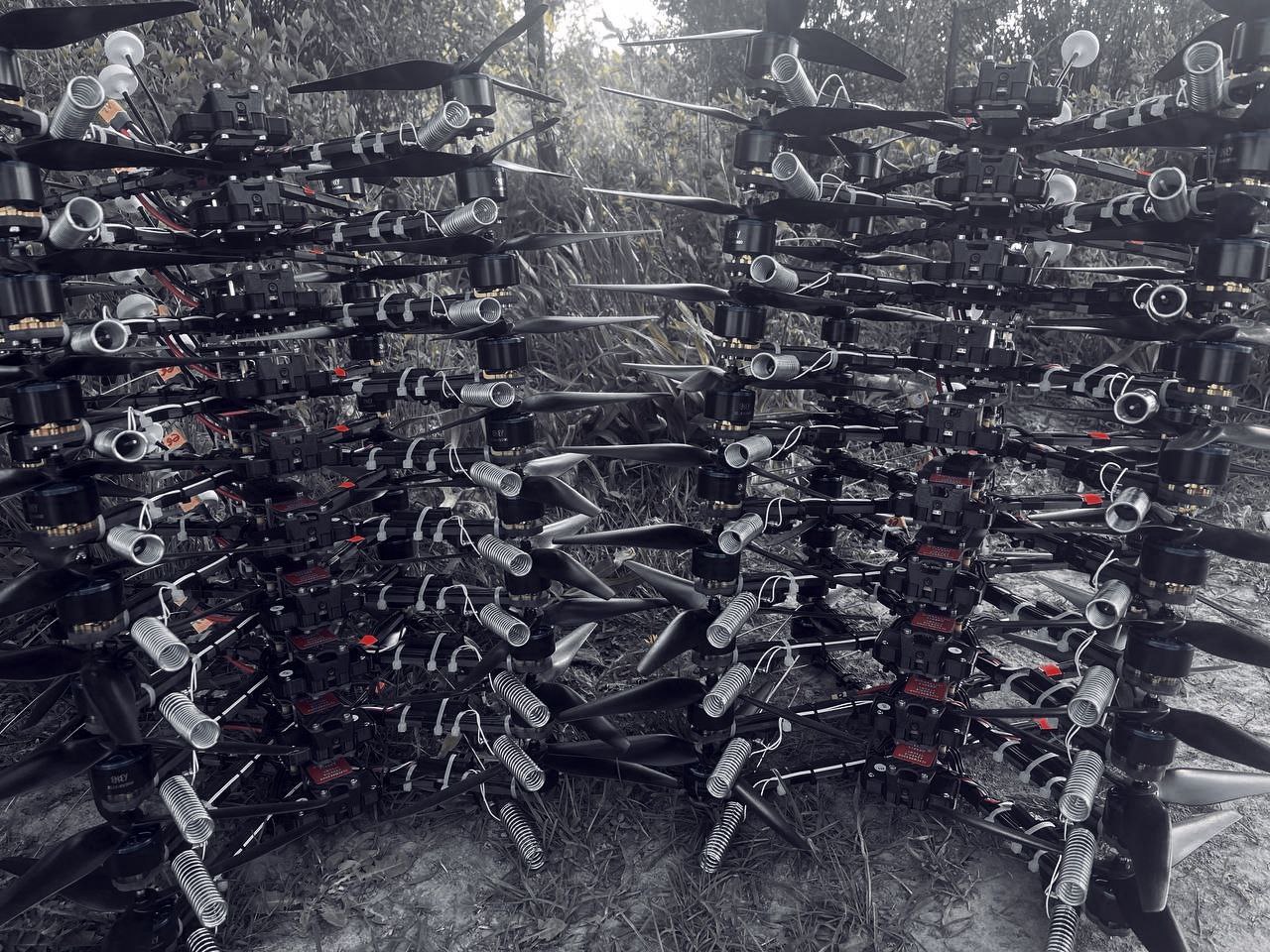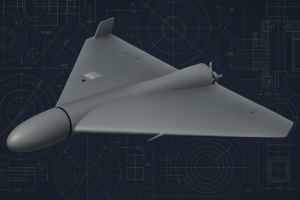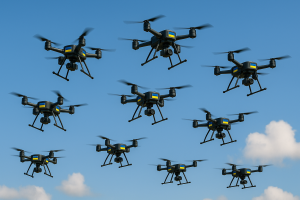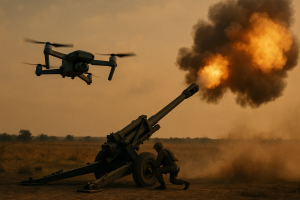Modern warfare is fundamentally different from conflicts of the past. While the overarching goals of the warring sides remain largely the same, the methods for achieving them are evolving rapidly.
The advancement of AI (Artificial Intelligence) has taken military operations to a new level. This is especially evident in the use of drones — unmanned aerial vehicles that have become one of the key weapons in contemporary warfare. AI plays a crucial role in shaping military strategies, which is clearly visible in the ongoing Russian-Ukrainian conflict. In this context, drones have proven to be a versatile tool for combat, reconnaissance, and striking enemy targets.
In this article, we’ll explore how artificial intelligence is being used in the military, and whether it’s truly as effective as machine vision technology.
What Is Artificial Intelligence?
Artificial intelligence is a hot topic everywhere. This technology can mimic human intelligence — it has the ability to “learn,” make decisions, and adapt to rapidly changing conditions. AI is built on the foundations of machine learning, neural networks, natural language processing (NLP), computer vision, and automated decision-making. It can process vast amounts of data at once, analyze it, recognize patterns, assess situations, and instantly choose the best action for a given scenario.
AI technologies are already widely used in medicine, industry, finance, logistics, education, and everyday life. Another key area for AI development and implementation today is the military — something that’s clearly illustrated by the nature of the ongoing war between Ukraine and Russia.
How AI Is Used in Warfare
The use of AI in combat has elevated warfare to a level that was previously out of reach. Thanks to AI, militaries are now deploying reconnaissance drones, demining robots, and autonomous combat platforms. Advanced technologies process satellite imagery, predict threats, detect attacks, and protect critical infrastructure — all in real time. AI also helps reduce human casualties by enabling virtual training and battle simulations, allowing soldiers to prepare for combat without being in harm’s way.
Ukraine is actively integrating AI into its military strategy, with a strong focus on developing autonomous drones and fire control systems. One example is the Saker Scout, a domestically produced drone capable of independently identifying up to 64 targets, including heavy military equipment. This UAV not only locates targets but also transmits coordinates for precision strikes — even under electronic warfare (EW) conditions. Its operational range is up to 10 kilometres.
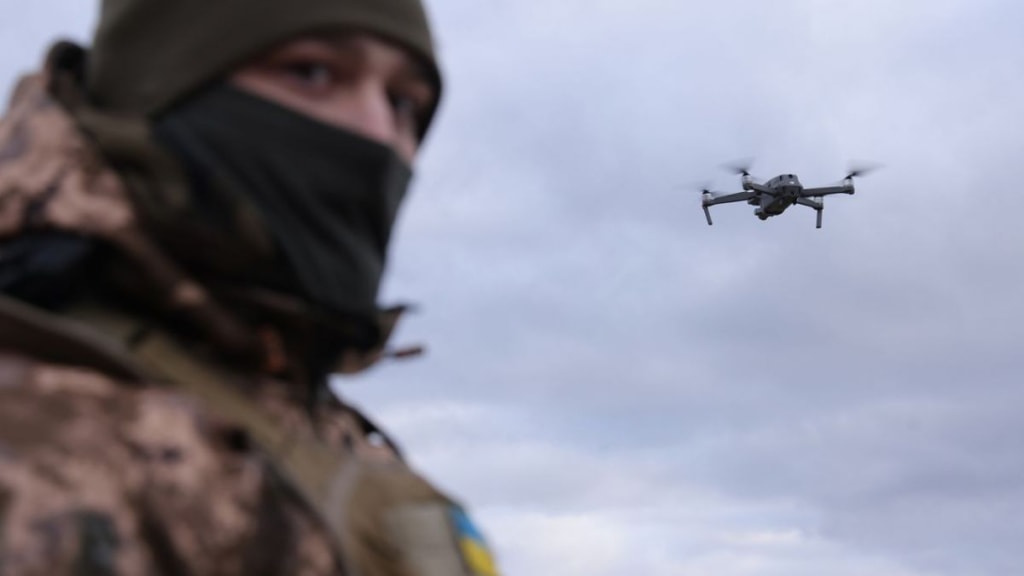
Intelligence is the foundation for effective military operations, and in this area, Ukrainian developers have also reached a new level. The Griselda reconnaissance system can process vast amounts of data in just 30 seconds. It collects information from UAVs, satellites, and various sources, including hacked enemy systems. This analysed data is then instantly transmitted to the Ukrainian Armed Forces.
For artillery strike coordination, Ukraine actively uses its own geoinformation system, Arta. By integrating Arta into operations, the time from identifying an enemy target to delivering a strike is significantly reduced. The system works by combining data from drones, satellites, and radar.
In October 2022, Ukraine presented its Delta situational awareness system to NATO, as reported by the military news outlet Militarnyi. This system gathers and analyses data from various sources, enabling the Ukrainian Armed Forces to adjust their operations and ensure effective coordination between different units. Real-time data processing is powered by cloud technologies and artificial intelligence.
Based on machine vision technology — which we’ll explore in more detail later — Ukrainian developers have also created automated turrets known as DevDroid. According to Yurii Porytskyi, founder of the DevDroid company, these automated machine guns can eliminate targets at distances of up to 800 meters.
Today, robotic systems — once the stuff of science fiction — are helping the Ukrainian Armed Forces take on the enemy at the most intense frontlines. One such system is the Droid TW, a Ukrainian-developed robotic platform built around a machine gun. It was designed to deliver highly effective reconnaissance and strike capabilities. The Droid TW performs well both day and night, autonomously detecting, identifying, and tracking targets. It is remotely operated, providing greater safety for personnel. The Ukrainian Ministry of Defense has confirmed that this system is already being used in real combat conditions.
There is less publicly available information about Russia’s use of AI in warfare. However, it is known that automatic targeting systems are being actively implemented in many of its drone models — including the Lancet drones used in the war against Ukraine. These developments have been reported by international media, including Reuters, one of the most reputable sources globally.
Artificial Intelligence and Ukrainian Drones: Smart Solutions for Victory
Today, Ukraine holds a leading position in the world when it comes to the combat use of FPV (first-person view) drones. This comes as no surprise — a prolonged war demands vast resources, making it essential to scale up the production and deployment of effective weapons and combat systems. Drones have now been integrated into nearly every aspect of military operations.
Ukraine’s decision to prioritize innovative technologies from the start of Russia’s full-scale invasion has proven successful. Drones are becoming more advanced, more efficient, and smarter. Let’s take a look at some practical examples of how this is working on the battlefield.
The Use of AI in Ukrainian Drones
FPV drones equipped with artificial intelligence offer powerful capabilities:
- GPS-free navigation. Crucial in electronic warfare (EW) conditions, these drones can “see” their way to the target, navigate using maps created by reconnaissance UAVs, and complete missions even if the operator’s signal is lost.
- Semi-autonomous strikes. Once the operator sets a target point or attack vector, the drone can independently guide itself and strike the target.
AI-enhanced reconnaissance drones have become especially widespread. Their use provides several key advantages:
- Real-time 3D maps of the terrain, which can later be used to guide strike drones;
- Detailed intelligence on enemy fortifications, hidden positions, and mined areas;
- Analytical insights on battlefield changes — such as the arrival of reinforcements or troop movements.
Work is already underway to develop features that will allow drones to autonomously plan offensive operations based on the data they collect. Following Russia’s invasion of Ukraine, the Ukrainian company Helsing formed strategic partnerships with Rheinmetall (September 2022) and Saab (September 2023). The main goal of these collaborations is to integrate AI into existing weapons systems and continue advancing their capabilities.
Innovations Helping Ukraine
Ukraine is constantly working on developing new, unique solutions using drones and AI. The results of this work are already visible today, including:
- Promising developments in “drone swarms” — Several drones working in synchronization, automatically coordinating with each other.
- Integration with reconnaissance drones — A rapid attack sequence in the chain: “target detection by reconnaissance drones — data transmission to FPV drones for a swift strike.”
- Anti-electronic warfare (EW) systems — AI-powered drones with minimal operator input that can identify sources of interference and adjust their flight paths accordingly.
Key Challenges of AI in Target Recognition
The use of artificial intelligence in warfare undeniably contributes to military success. However, it also comes with a number of challenges — not only technical, but also legal and ethical.
One of the most significant issues is the accuracy and reliability of target recognition. In controlled environments, AI systems can achieve near-perfect identification rates. But in real combat situations, this accuracy drops significantly due to factors such as:
- Incomplete or inaccurate data, caused by interference or poor visibility;
- Changing environmental conditions, such as weather or lighting.
AI systems are used to identify objects, but the “friend or foe” distinction is not always reliable. There’s a risk that civilian objects may be mistakenly identified as military targets.
Another major challenge is decision-making complexity. While automating decision-making processes helps reduce the workload on personnel, it also introduces several important issues:
- Loss of human decision-making skills in critical, high-pressure situations;
- Lack of transparency around how and why an AI system makes a particular decision.
Beyond the technical challenges, there are also serious ethical and legal concerns. Who is responsible for the actions taken by AI? Is it morally acceptable to delegate life-and-death decisions to machines?
These are urgent questions — not only for Ukraine but for the entire civilized world. The conclusion is clear: the use of AI in armed conflicts must be subject to strict international oversight.
At the end of April 2024, representatives from international organizations and diplomats met in Vienna to discuss the need to regulate the use of AI and autonomous weapons in warfare. (9).
Safe use of AI in war will only be possible after the development and adoption of comprehensive international standards, agreed upon by all parties to a conflict.
What Are Computer Vision Systems, and How Do They Differ from Artificial Intelligence?
When discussing the implementation of modern digital solutions in warfare, it’s important to look not only at the role of AI but also at computer vision systems — which are now fundamental to the targeting technologies used in military drones.
Advantages of Computer Vision
Computer vision has become the “eyes” of drones. This technology enables computers to “see” images in real time and analyze them. While artificial intelligence is a broad field that imitates human intelligence, computer vision is a specialized system that includes AI among other techniques.
Computer vision allows machines to observe and understand their surroundings much like humans do — by analysing and interpreting static images or video and producing insights as a human brain would. Put simply, it mimics both the function of human sight and the brain’s visual processing. It “sees” an image and “understands” what is in it.
The process works as follows:
- Camera captures an image.
- Algorithms immediately process and analyze it, enhancing it if needed for better recognition.
- The system identifies what kind of object is in the image and transmits that information for further action.
Using computer vision in drone engineering brings several important advantages:
- Rapid recognition of targets from the air — including vehicles, people, and weaponry.
- Continuous tracking and monitoring of targets.
- Real-time map generation, enabling precise operational planning.
One clear benefit is the drone’s ability to identify a specific enemy vehicle among many objects. This reduces the risk of mistakenly striking the wrong target, improving both accuracy and safety.
Advantages of Artificial Intelligence
The integration of artificial intelligence (AI) into military drones brings significant benefits. Continuous improvements are being made to existing systems, and in the near future, we can expect to see the following advancements:
- Drones will be able to independently choose their flight paths, taking into account real-time threat assessments and strategic data about planned attacks.
- Changes in enemy tactics will trigger adaptive responses, as AI learns from every new experience and works quickly to correct past mistakes.
However, even today, UAV systems based on artificial intelligence offer significant improvements in the performance of both reconnaissance and strike drones. This has become possible due to enhanced data processing, which now includes not only inputs from drone cameras, but also from radars, GPS, thermal imagers, and more. These combined data sets, processed instantly by AI, provide far greater capabilities for military operations.
Optimal results can be achieved by combining AI and computer vision technologies in drone applications. Work in this direction is already underway, and this combination allows for significantly enhanced outcomes. AI handles data — especially large-scale data — and makes predictions. The task of computer vision is to process the real-time “visual input.” For example, terrain mapping using computer vision becomes most effective when the data is further analyzed by AI, which then makes decisions about the next steps — whether to attack, avoid, or continue observation.
Why does computer vision currently outperform artificial intelligence when it comes to targeting systems?
When assessing the effectiveness of technologies specifically in the context of targeting systems, it can be confidently stated that computer vision currently outperforms AI algorithms by many criteria:
- Computer vision, controlled by a human operator, performs a range of tasks with greater precision — it detects objects in real time, processes camera data, and determines coordinates. It does not require lengthy analysis, which is invaluable in situations where decisions must be made within seconds.
- Visual models managed by an operator are capable of recognising even the smallest objects at long distances. They perform well in difficult conditions (e.g., poor visibility, low light), and can detect moving targets across varied backgrounds.
- Despite its advantages, AI requires more expensive infrastructure to integrate into UAV designs, unlike computer vision systems. The latter can be easily installed into processing units without additional complications or significant costs.
- Reliability and speed are crucial in high-intensity combat environments. Computer vision operates on predefined algorithms, ensuring rapid response in the “see–act” chain.
A clear example of computer vision’s advantage over AI is the VGI-9 drone targeting system. By using object detection algorithms and cameras based on computer vision, it can analyse the situation in real time and transmit coordinates to drone control systems. Priority is given to rapid visual identification of enemy targets and precise targeting.
VGI-9 CTO on Revolutionizing Drone Targeting in Combat — read in our recent post.
Drone Swarms and Artificial Intelligence
Based on military technologies involving artificial intelligence (AI) and computer vision, some of the most effective drone systems are currently being developed. One innovation with the potential to transform modern warfare is the drone swarm.
The concept of swarms is inspired by insect groups that operate collectively, in coordination, without centralized control. Similarly, drone swarms consist of a group of unmanned aerial vehicles (UAVs) that simultaneously carry out a common task and interact with one another autonomously through AI and computer vision technologies.
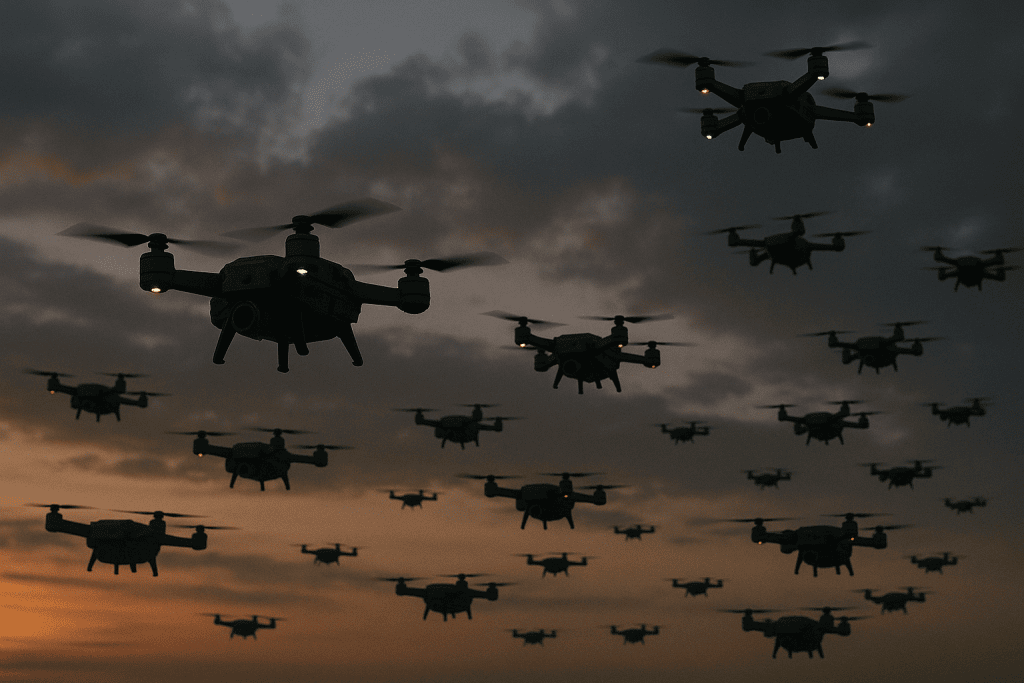
Information exchange between swarm units is enabled by wireless networks, allowing drones to synchronize their actions and make decisions instantly, without external input. The loss of one or even several drones does not affect the effectiveness of the mission. Moreover, the number of drones in a swarm can be scaled up or down as needed.
Let’s take a look at some real-world use cases of drone swarms.
Since 2017, the U.S. company DARPA has been developing the Offensive Swarm-Enabled Tactics (OFFSET) drone control system, designed to coordinate the operation of up to 250 drones simultaneously. These include both aerial and ground-based robotic units.
In 2020, China demonstrated drone swarm deployment using specially equipped transport vehicles. The swarm was capable of forming groups of multiple UAVs, manoeuvring, and overcoming obstacles. Development in this field is ongoing to this day.
Development of Drone Swarm Technology in Ukraine
The development of AI-based robotic systems was already underway in Ukraine prior to the full-scale invasion. However, since February 2022, this direction has gained particular importance. Ukraine has become one of the countries actively working on the development of drones for combat operations. Official initiatives have been launched to support this effort, including the Brave1 Platform, which coordinates and funds military startups and projects involving FPV drone swarms in particular.
Work is being carried out to develop new drone swarm systems. The Swarmer company is developing effective swarms based on artificial intelligence and machine vision, enabling the integration of a large number of drones into a single system controlled by one operator (the Styx system).
In 2024, ₴40 billion (UAH) were allocated for the purchase of drones and for funding the development of drone swarms. As noted by Ukrainian Prime Minister Denys Shmyhal, almost 50% of this amount is planned to be spent within Ukraine — targeted at acquiring domestically developed drones, improving existing projects, and supporting new innovations.
Conclusions
Artificial intelligence is transforming the nature of modern warfare. The efficiency of combat operations is increasing, along with the accuracy of target detection and strikes. This has become possible thanks to the integration of drones into military operations, which clearly demonstrate the advantages of AI and machine vision technologies in the military sphere.
Ukraine is actively developing aerial vehicles based on artificial intelligence and machine vision. Ukrainian-made drones, artillery turrets, and data processing systems are already being widely used in the ongoing Russia-Ukraine war. The integration of innovative technologies into drone systems has significantly improved the accuracy of enemy target identification. GPS-free navigation has become possible even under electronic warfare (EW) conditions, and semi-autonomous attacks are now carried out based on coordinates detected by drones. Intelligence gathered by reconnaissance units is transmitted instantly and processed in real time.
Today, Ukraine, along with many other countries, is actively working on the development and deployment of drone swarms — autonomous systems consisting of large numbers of UAVs capable of operating synchronously without human intervention. The results of both startup and government initiatives are already being tested on the battlefield and are showing effective results. To achieve maximum efficiency, developers are focusing on integrating machine vision systems, which demonstrate several advantages over AI: they require less space on board and can operate using more affordable microcomputers. At the same time, they offer many of the same benefits as AI — high-speed real-time data acquisition and processing, improved object recognition accuracy, and expanded functionality. The combination of AI and machine vision delivers the best possible outcomes.
Contact us to get detailed information about the VGI-9 drone guidance system.
Follow our updates on social media and YouTube – there you will find:
✅ Exclusive materials on the development, testing, and combat use.
✅ Useful analytical content on the war and the role of FPV drones in modern combat operations.
✅ The latest news and insights from the world of military technologies.
📌 Join us:
🔗 YouTube: VGI-9 on YouTube
📸 Instagram: We are on Instagram
🎯 TikTok: We are on TikTok



